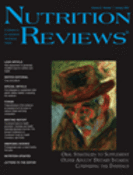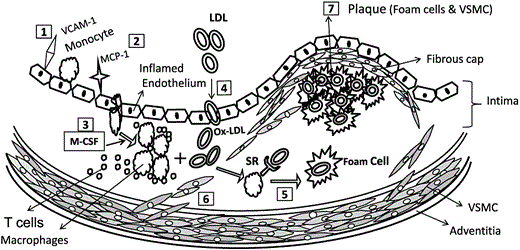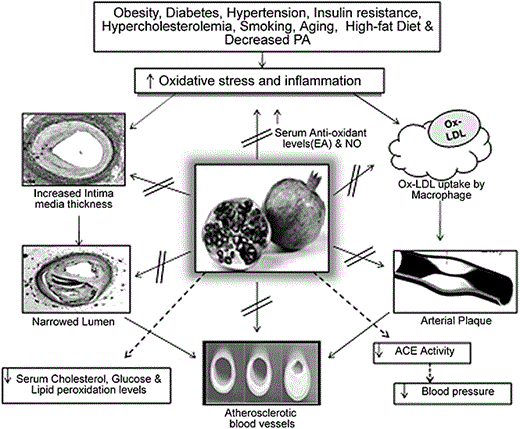-
PDF
- Split View
-
Views
-
Cite
Cite
Arpita Basu, Kavitha Penugonda, Pomegranate juice: a heart-healthy fruit juice, Nutrition Reviews, Volume 67, Issue 1, 1 January 2009, Pages 49–56, https://doi.org/10.1111/j.1753-4887.2008.00133.x
Close - Share Icon Share
Abstract
Pomegranate juice is a polyphenol-rich fruit juice with high antioxidant capacity. In limited studies in human and murine models, pomegranate juice has been shown to exert significant antiatherogenic, antioxidant, antihypertensive, and anti-inflammatory effects. Pomegranate juice significantly reduced atherosclerotic lesion areas in immune-deficient mice and intima media thickness in cardiac patients on medications. It also decreased lipid peroxidation in patients with type 2 diabetes, and systolic blood pressure and serum angiotensin converting enzyme activity in hypertensive patients. Thus, the potential cardioprotective benefits of pomegranate juice deserve further clinical investigation, and evidence to date suggests it may be prudent to include this fruit juice in a heart-healthy diet.
INTRODUCTION
According to the findings of the National Vital Statistics Report (2008) and the Morbidity and Mortality Weekly Report (2007) of the Centers for Disease Control and Prevention (CDC), cardiovascular disease (CVD) continues to rank high among the leading causes of morbidity and mortality in adults in the United States.1,2 While diet and increased physical activity constitute the primary preventive health approach, the role of plant-based bioactive compounds or phytochemicals has attracted much attention due to their unique cardioprotective benefits.3,–6 Several epidemiological studies suggest that dietary patterns characterized by relatively high intakes of fruits and vegetables are significantly associated with reduced risks of coronary heart disease (CHD) and stroke.7,–9 Fruits and vegetables present a heart-healthy and colorful array of phytochemicals including carotenoids, and polyphenols like flavonoids, resveratrol, and ellagitannins, isothiocyanates, and organosulfur compounds, each of which has been shown to be associated with lower risks of cardiovascular disease.10,–16 However, observational studies and clinical trials investigating the cardiovascular health benefits of fruits and vegetables, attribute these effects to the combination of phytochemicals, fiber, and other nutrients in whole food intake, rather than the sole effects of an individual component. Phytochemicals are potent antioxidants and anti-inflammatory agents, thereby counteracting oxidative damage and inflammation which underlie the pathogenesis of CVD.17,–20 Thus, in addition to the general recommendation of consuming five to nine servings of fruits and vegetables daily,21 emphasis is needed on the importance of the specific phytochemical-containing fruits and vegetables that have been shown to lower CVD risk factors in patients and in healthy subjects.22,–26 While the chemistry, bioavailability, efficacy, and safety of novel phytochemicals are being identified, it is prudent for nutrition researchers to emphasize their role in the prevention and treatment of clinical outcomes at different stages of CVD, and dissemination of this information to the general public.
ATHEROSCLEROSIS, OXIDATIVE STRESS, AND INFLAMMATION
Atherosclerosis, a major degenerative disease of arteries involves a series of inflammatory and oxidative modifications within the arterial wall.27,Figure 1 exhibits the role of oxidative stress and inflammation in the initiation and progression of atherosclerosis, as postulated by previous research.28,–31 Emerging research shows that obesity, hypertension, diabetes mellitus, dyslipidemia, smoking, aging, diets rich in saturated fats, and reduced physical activity are the established risk factors for atherosclerosis,30,–39 which is also characterized by inflammation and oxidant burden.28,39
Oxidative stress and inflammation in initiation and progression of atherosclerosis. (1) VCAM-1 promoting monocyte adhesion. (2) MCP-1 mediating monocyte migration into intima. (3) M-CSF promoting monocyte maturation into macrophage. (4) LDL deposition in intima and oxidative modification to Ox-LDL. (5) Macrophages engulfing Ox-LDL through SR and converting as foam cells. (6) T cells promoting VSMC proliferation and migration into intima. (7) Plaque formation: foam cells surrounded by VSMC. Macrophages, T cells, foam cells, and VSMC secrete pro-inflammatory cytokines and collagenases that aggravate the process of atherosclerosis and lead to thrombotic event. Abbreviations: VCAM-1, vascular cell adhesiom molecule-1; MCP-1, monocyte chemoattractant protein-1; M-CSF, macrophage colony-stimulating factor; VSMC, vascular smooth muscle cell; SR, scavenger receptor.
Oxidative stress, an imbalance between free radical formation and antioxidant status, is the major contributor to CVD, and inflammation is a manifestation of oxidative stress. Oxidative stress induces inflammation by acting on the pathways that generate inflammatory mediators like adhesion molecules and pro-inflammatory cytokines.40,41 Recent human studies have shown significant positive associations between oxidative stress and inflammation and indicators of vascular damage, like impaired endothelial function42 and arterial stiffness.29,–43 Oxidative stress and inflammation also induce vascular smooth muscle cell (VSMC) activation and proliferation, angiogenesis, lipid peroxidation, and platelet activation.33,–45 C-reactive protein (CRP), vascular cell adhesion molecule-1 (VCAM-1), tumor necrosis factor- α (TNF-α), interleukin-1 (IL-1), interleukin-18 (IL-18), soluble CD40 ligand (sCD40L), and monocyte matrix metalloproteinase 9 (MMP-9) are biomarkers of inflammation.46,47 Whereas, lipid peroxidation, oxidized-LDL, and urinary 8-isoprostane levels are the oxidative biomarkers of CVD risk factors.48
Oxidative stress and inflammation lead to endothelial dysfunction by reducing nitric oxide (NO) bioavailability due to the formation of peroxy nitrite, which is cytotoxic.42,–50 Inflamed endothelial cells (EC) express VCAM-1 and promote monocyte adhesion, an initial step in atherosclerosis. Selectins, integrins, and monocyte chemoattractant protein-1 (MCP-1) expressed on EC mediate attachment and migration of monocytes into the intima, where they reside and multiply. Inflamed intima expresses macrophage colony stimulating factor (M-CSF), which promote monocyte maturation into macrophage. Atherogenic lipoproteins, like low-density lipoproteins (LDL) and very-low-density lipoprotein (VLDL), deposit in subintimal space and undergo oxidative modifications resulting in the formation of oxidized LDL. Macrophages express scavenger receptors and then engulf oxidized LDL to form lipid-laden foam cells. Macrophages further progress the process of atherosclerosis by secreting pro-inflammatory cytokines like TNF-α, IL-1β. T cells join macrophages and promote plaque formation by inducing VSMC migration and proliferation. During the final stage, VSMC express enzymes that degrade collagen, weaken the fibrous plaque cap and make it prone to rupture. Inflammatory stimuli also increase the expression of pro-coagulant tissue factor, which triggers thrombus formation when the plaque ruptures. Thrombus formation leads to acute coronary syndrome.27,–51 Thus, both oxidative stress and inflammation initiate, participate in, and enhance the process of atherosclerosis, and are the principal targets of therapeutic interventions with dietary phytochemicals, in preserving the endothelium or reversing atherosclerosis.23,–58
POMEGRANATE POLYPHENOLS
Antioxidant potency and bioavailability
Pomegranate fruit (Punica granatum L.) cultivated in India, Spain, Israel, and the United States has been rated to contain the highest antioxidant capacity in its juice, when compared to other commonly consumed polyphenol-rich beverages in the United States.59,60 The antioxidant capacity of pomegranate juice was shown to be three times higher than that of red wine and green tea, based on the evaluation of the free-radical scavenging and iron-reducing capacity of the juices.61 It was also shown to have significantly higher levels of antioxidants in comparison to commonly consumed fruit juices, such as grape, cranberry, grapefruit, or orange juice.62,63 The principal antioxidant polyphenols in pomegranate juice include the ellagitannins and anthocyanins.61 Ellagitannins account for 92% of the antioxidant activity of pomegranate juice and are concentrated in the peel, membranes, and piths of the fruit. Punicalagins are the major ellagitannins in the whole fruit and can be hydrolyzed to ellagic acid (EA) and other smaller polyphenols in vivo.64 Commercial pomegranate juice obtained by pressing the whole pomegranate fruit and its peels contains significant amounts of the water-soluble punicalagins, and these levels are variable depending on the fruit cultivar, processing, and storage conditions.61,65
The potential health benefits of pomegranate juice consumption make it crucial to understand the bioavailability of pomegranate polyphenols. An acute supplementation of 800 mg of pomegranate extract containing 330 mg of punicalagins and 22 mg of EA (POMELLA, Noblesville, IN) in 11 healthy volunteers, led to the detection of ellagitannin metabolites, including EA, urolithin A, hydroxyl-urolithin A, urolithin B, urolithin A-glucuronide, and dimethylellagic acid glucuronide (DMEAG) in plasma samples drawn between 2 and 24 h postprandial. High interindividual variability was observed in the pharmacokinetics of these metabolites, while no intact punicalagins were detected. The antioxidant capacity of plasma was increased significantly by 32% at 0.5 h postprandial, while no effects were observed on the generation of reactive oxygen species and biomarkers of inflammation.59
Consumption of 180 mL of pomegranate juice containing 25 mg of EA (POM®Wonderful, Los Angeles, CA) by a healthy human subject led to the detection of EA at a maximum concentration of 32 ng/mL in a 1 h postprandial plasma sample and was shown to be rapidly eliminated by 4 h. No data were reported on other ellagitannin metabolites.64 Data reported by the same study group, following supplementation of 180 mL of pomegranate juice concentrate (POM®Wonderful, Los Angeles, CA) in 18 healthy volunteers, showed that EA was present in all plasma samples at approximately 1 h post ingestion. However, EA metabolites, mainly DMEAG and urolithins, were also detected in plasma and urine of most subjects; the authors suggest genetic polymorphisms in EA-metabolizing enzymes account for these interindividual variabilities.66
On the other hand, pharmacokinetic data on laboratory-prepared pomegranate juice polyphenols in healthy volunteers or in patients with chronic obstructive pulmonary disease in Europe showed undetectable levels of punicalagins or EA in plasma or urine samples.67,68
Thus, on the basis of limited human studies, it appears that estimation of the bioavailability of pomegranate polyphenols is affected by several factors, including: interindividual variability, differential processing of pomegranate juice, as well as the use of analytical techniques sensitive enough to detect low postprandial concentrations of these metabolites. Ellagic acid may be a more stable biomarker in comparison to the intact punicalagins and other ellagitannin metabolites, which are non-detectable and highly variable in human plasma and urine, respectively.
Therapeutic effects in diabetes and atherosclerosis
A recently reported study on the supplementation of pomegranate juice (PJ), pomegranate fruit liquid extract (POMxl), pomegranate polyphenol powder extract (POMxp), or pomegranate ground flowers extract (POMf) in an atherosclerotic mouse model for 3 months revealed a significant reduction in the atherosclerotic lesion area compared to the water-treated group.54 Interestingly, the largest decrease in lesion area (70%) was observed in mice supplemented with POMf, which had the highest content of total dietary fiber (30.2%) among all fruit parts, and also led to a concomitant decrease in serum glucose and cholesterol levels, compared to the placebo group. PJ led to a significant reduction in the atherosclerotic lesion area (44%), had no effects on serum glucose and lipid levels, caused a significant decrease in native LDL uptake by the peritoneal macrophages in mice, and stimulated HDL-mediated cholesterol efflux from mice peritoneal macrophages, compared to the placebo animals. All of the above pomegranate fruit extracts and the juice were supplied by POM Wonderful (Los Angeles, CA). While PJ had no fiber and a higher polyphenol content (3600 µg/mL) compared to POMf (166 µg/gm), the latter led to a larger decrease in lesion area, which the authors attribute to the synergistic action of polyphenols, dietary fiber, and other carbohydrates in POMf. The researchers in this study further report significant antioxidant capacities of all POM extracts, though PJ had a higher free-radical-scavenging capacity compared to POMf. Pomegranate seed oil, containing only fatty acids and added antioxidants like tocopherols and ascorbyl palmitate, was also used in the study, but revealed no effects on atherosclerotic lesion size versus placebo. The anti-atherogenic and vasculoprotective activities of pomegranate fruit or extracts have also been shown previously in mouse models;69,–72 these can be largely attributed to the unique blend of polyphenols and complex carbohydrates, leading to cardiovascular health benefits.
Inflammation
A 5-week supplementation of pomegranate juice or pomegranate fruit extract (PFE) in obese Zucker rats fed an atherogenic diet, showed a significant decrease in the expression of vascular inflammation markers, thrombospondin (TSP), and cytokine transforming growth factor-β1 (TGF-β1). Arterial endothelial-nitric oxide synthase (eNOS) expressions were significantly increased in animals supplemented with pomegranate juice or PFE, in comparison to controls.55 Nitric oxide plays an important role as an antioxidant and anti-inflammatory agent in the endothelial cells and thereby attenuates the progression of atherosclerosis.73 Pomegranate juice has also been shown to prevent oxidative destruction of nitric oxide and enhance its antioxidant and anti-inflammatory functions.74 The anti-inflammatory effects of pomegranate extracts have also been shown using a collagen-induced arthritis mouse model,75 and they have been shown to reduce human prostate cancer xenografts in immune-deficient mice by inhibiting inflammatory and angiogenic pathways.76,77 However, these anti-inflammatory effects of pomegranate juice in protecting the endothelium and attenuating atherosclerosis have yet to be demonstrated in clinical trials.
Safety
Supplementation of 710 mg or 1420 mg of an ellagitannin-enriched pomegranate polyphenol extract for 4 weeks was shown to be safe and well-tolerated in 64 overweight individuals with increased waist size and no chronic disease. No treatment-related adverse events were reported and hematology, chemistry, and urinalysis laboratory reports were within the normal range.14 Oral administration of a 6% punicalagin-containing diet for 37 days showed no toxic effects in Sprague-Dawley rats.78 Thus, on the basis of limited safety data, high doses of pomegranate polyphenol extracts may be safe for human health, though their safety in patients with cardiovascular diseases has not been established.
POMEGRANATE JUICE CLINICAL TRIALS IN PATIENTS WITH TYPE 2 DIABETES, ATHEROSCLEROSIS, OR HYPERTENSION
An 8-week study was conducted among 22 type II diabetic patients supplemented with 40 g/day of concentrated pomegranate juice that contained significant amounts of fiber (2.1 g/100 g), sugars (15.6 g/100 g), and total polyphenols (875 mg/100 g).79 The study found a significant reduction in total cholesterol and LDL-cholesterol, while no effects were seen in triglycerides and HDL-cholesterol concentrations. Prior to the start of the study, the subjects were asked to participate in an 8-week pre-study period, during which they carefully recorded all dietary intakes and were trained in maintaining food records. However, since this study had no control group, it is difficult to interpret the findings.
In a 3-month study of 10 type II diabetic patients and 10 healthy controls consuming 50 ml of pomegranate juice/day, no significant changes were noted in serum glucose or lipid levels versus controls. However, the pomegranate juice used in this study, containing significant amounts of polyphenols (1979 mg/L of ellagitannins) but no fiber, significantly decreased lipid peroxidation levels and cellular uptake of ox-LDL by monocyte-derived macrophages from the diabetic patients, which could attenuate the progression of atherosclerosis.80
Pomegranate juice consumption (50 mL/day, 1979 mg/L ellagitannins) by ten patients with carotid artery stenosis for 1 year led to a significant reduction in mean intima-media thickness (IMT), systolic blood pressure, and serum lipid peroxidation compared to baseline values, while no changes were reported in serum glucose and lipid levels. Five of ten patients continued to drink pomegranate juice for up to 3 years but showed no additional benefits on IMT and systolic blood pressure, although serum lipid peroxidation was further reduced by 16% in these patients. Interestingly, these patients were treated with hypercholesterolemic and anti-hypertensive drugs throughout the study, indicating an additive or synergistic action of pomegranate juice on the clinical outcomes.23 An earlier clinical trial also found reduced systolic blood pressure and serum angiotensin converting enzyme activity following 2 weeks of pomegranate juice consumption (50 mL/day) in 10 hypertensive subjects, adding further support to the anti-hypertensive effect of pomegranate juice.81
The clinical studies discussed so far were conducted in Middle Eastern countries; there have been limited studies in Western populations on the anti-atherosclerotic, anti-hypertensive, or anti-diabetic effects of pomegranate juice. In a 3-month randomized, double-blind, placebo-controlled study conducted in California among 45 patients with incident myocardial ischemia, pomegranate juice (240 mL/day, POM Wonderful, Los Angeles, CA) caused a significant decrease in stress-induced ischemia in comparison to placebo. No changes were noted, however, in anthropometric measurements, blood pressure, serum glucose, and lipid profiles versus placebo.24 Thus, future clinical trials in patients on multiple medications will further strengthen the therapeutic role of pomegranate juice in cardiovascular disease.
CONCLUSION
Pomegranate juice has shown significant anti-atherosclerotic, anti-hypertensive, antioxidant, and anti-inflammatory effects in human subjects and mouse models (Figure 2). The principal mechanisms of action of pomegranate juice may include the following: increased serum antioxidant capacity, decreased plasma lipids and lipid peroxidation, decreased oxidized-LDL uptake by macrophages, decreased intima media thickness, decreased atherosclerotic lesion areas, enhanced biological actions of nitric oxide, decreased inflammation, decreased angiotensin converting enzyme activity, and decreased systolic blood pressure, thereby causing an overall favorable effect on the progression of atherosclerosis and the subsequent potential development of coronary heart disease.
Cardioprotective mechanisms of pomegranate polyphenols.
Abbreviations: PA, physical activity; EA, ellagic acid; ACE, angiotensin converting enzyme; NO, nitric oxide.  inhibition by pomegranate polyphenols.
inhibition by pomegranate polyphenols.
In comparison with commonly consumed fruit juices, green tea, and black tea, which have been shown to increase serum antioxidant capacity or decrease oxidative damage of biomolecules,82,–84 pomegranate juice exerts additional cardioprotective benefits by decreasing or reversing the progression of ischemic lesion areas, as well as having a beneficial effect on intimal media thickness and systolic blood pressure. Also, the fact that pomegranate juice supplementation produced significant effects in patients on multiple medications is promising because it suggests pomegranate juice may be an effective source of adjunct phytotherapy in patients at risk of heart disease who are following a heart-healthy diet.
Thus, based on limited, but promising human data, it appears that pomegranate juice supplementation in the form of at least one to two cups a day may exert beneficial effects in subjects with type 2 diabetes and CVD, and boost antioxidant defense mechanisms in healthy volunteers. Pomegranate polyphenol extracts, up to 1400 mg appear to be safe, though most of the clinical trials that have shown significant beneficial effects with pomegranate juice have been made commercially or carefully extracted under controlled laboratory settings by the researchers. Pomegranate juice may be considered the most heart-healthy fruit juice and awaits additional clinical research to further strengthen support for its unique cardioprotective effects.
REFERENCES





